Investigation of Mixed-Mode I/II Fracture under Impact Loading Using Split-Hopkinson Pressure Bar
Abstract
1. Introduction
2. Experiment
2.1. Specimen and Experimental System
2.2. Crack Propagation Gauge
2.3. Discussion of Experimental Results
3. Dynamic Initiation Stress Intensity Factor
3.1. Verification of ABAQUS
3.2. Determination of Dynamic Initiation Stress Intensity Factor
4. Numerical Approach
4.1. Numerical Model of AUTODYN
4.2. Numerical Result
5. Conclusions
- During the mixed-mode I/II crack propagation process, the deceleration of crack extending velocity would occur at the deflection area of the crack path, which is the flag of fracture mode transformation.
- The variable angle single cleavage semi-circle (VASCSC) specimen is applicable to the investigation of mixed-mode fracture with SHPB device. It can not only be applied in crack propagation behavior study but also employed for determining dynamic initiation fracture toughness of brittle material with the mixed-mode fracture.
- The AUTODYN can be applied in predicting crack propagation of mixed-mode I/II for brittle material under dynamic loading with guaranteed precision.
Author Contributions
Funding
Conflicts of Interest
References
- Zhou, L.; Zhu, Z.M.; Dong, Y.Q.; Fan, Y.; Zhou, Q.; Deng, S. The influence of impacting orientations on the failure modes of cracked tunnel. Int. J. Impact Eng. 2019, 125, 134–142. [Google Scholar] [CrossRef]
- Rossmanith, H.P.; Daehnke, A.; Knasmillner, R.E.; Kouzniak, N.; Ohtsu, M.; Uenishi, K. Fracture mechanics applications to drilling and blasting. Fatigue Fract. Eng. Mater. Struct. 1997, 20, 1617–1636. [Google Scholar] [CrossRef]
- Eberhardt, E.; Stead, D.; Stimpson, B.; Read, R.S. Identifying crack initiation and propagation thresholds in brittle rock. Can. Geotech. J. 1998, 35, 222–233. [Google Scholar] [CrossRef]
- Soh, A.K.; Yang, C.H. Numerical modeling of interactions between a macro-crack and a cluster of micro-defects. Eng. Fract. Mech. 2004, 71, 193–217. [Google Scholar] [CrossRef]
- Lang, L.; Zhu, Z.M.; Zhang, X.S.; Qiu, H.; Zhou, C.L. Investigation of crack dynamic parameters and crack arresting technique in concrete under impacts. Construre Build. Mater. 2019, 199, 321–334. [Google Scholar] [CrossRef]
- Yue, Z.W.; Song, Y.; Yang, R.S.; Yu, Q. Comparison of caustics and the strain gage method for measuring mode I stress intensity factor of PMMA material. Polym. Test. 2017, 59, 10–19. [Google Scholar] [CrossRef]
- Ravi-Chandar, K.; Knauss, W.G. An experimental investigation into dynamic fracture: I. Crack initiation and arrest. Int. J. Fract. 1984, 25, 247–262. [Google Scholar] [CrossRef]
- Freund, L.B. Dynamic Fracture Mechanics; Cambridge University Press: New York, NY, USA, 1990; 563p. [Google Scholar]
- Gao, G.; Yao, W.; Xia, K.; Li, Z. Investigation of the rate dependence of fracture propagation in rocks using digital image correlation (DIC) method. Eng. Fract. Mech. 2015, 138, 146–155. [Google Scholar] [CrossRef]
- Wang, F.; Wang, M.; Nezhad, M.M.; Qiu, H.; Ying, P.; Niu, C.Y. Rock Dynamic Crack Propagation under Different Loading Rates Using Improved Single Cleavage Semi-Circle Specimen. Appl. Sci. 2019, 9, 4944. [Google Scholar] [CrossRef]
- Chen, R.; Xia, K.; Dai, F.; Lu, F.; Luo, S.N. Determination of dynamic fracture parameters using a semi-circular bend technique in split Hopkinson pressure bar testing. Eng. Fract. Mech. 2009, 76, 1268–1276. [Google Scholar] [CrossRef]
- Meng, W.; Zhu, Z.; Dong, Y.; Lei, Z. Study of mixed-mode I/II fractures using single cleavage semicircle compression specimens under impacting loads. Eng. Fract. Mech. 2017, 177, 33–44. [Google Scholar]
- Wang, F.; Wang, M.; Zhu, Z. Rock Dynamic Crack Propagation Behaviour and Determination Method with Improved Single Cleavage Semi-circle Specimen Under Impact Loads. Acta Mech. Solida Sin. 2020. [Google Scholar] [CrossRef]
- Chang, S.H.; Lee, C.I.; Jeon, S. Measurement of rock fracture toughness under modes I and II and mixed-mode conditions by using disc-type specimens. Eng. Geol. 2002, 66, 79–97. [Google Scholar] [CrossRef]
- Aliha, M.R.M.; Mousavi, S.S.; Bahmani, A.; Linul, E.; Marsavina, L. Crack initiation angles and propagation paths in polyurethane foams under mixed modes I/II and I/III loading. Theor. Appl. Fract. Mech. 2019, 101, 152–161. [Google Scholar] [CrossRef]
- Eftekhari, M.; Baghbanan, A.; Hashemolhosseini, H. Fracture propagation in a cracked semicircular bend specimen under mixed mode loading using extended finite element method. Arab. J. Geosci. 2015, 8, 9635–9646. [Google Scholar] [CrossRef]
- Ayatollahi, M.R.; Aliha, M.R.M. Fracture toughness study for a brittle rock subjected to mixed mode I/II loading. Int. J. Rock Mech. Min. Sci. 2007, 44, 617–624. [Google Scholar] [CrossRef]
- Gregoire, D.; Maigre, H.; Rethore, J.; Combescure, A. Dynamic crack propagation under mixed-mode loading-Comparison between experiments and X-FEM simulations. Int. J. Solids Struct. 2007, 44, 6517–6534. [Google Scholar] [CrossRef]
- Lin, Q.; Wan, B.; Wang, S.Q.; Li, S.Y.; Fakhimi, A. Visual detection of a cohesionless crack in rock under three-point bending. Eng. Fract. Mech. 2019, 211, 17–31. [Google Scholar] [CrossRef]
- Aliha, M.R.M.; Mousavi, S.S.; Ghoreishi, S.M.N. Fracture load prediction under mixed mode I plus II using a stress based method for brittle materials tested with the asymmetric four-point bend specimen. Theor. Appl. Fract. Mech. 2019, 103, 102249. [Google Scholar] [CrossRef]
- Al-Shayea, N.A. Crack propagation trajectories for rocks under mixed mode I-II fracture. Eng. Geol. 2005, 81, 84–97. [Google Scholar] [CrossRef]
- Zuo, J.P.; Yao, M.H.; Li, Y.J.; Zhao, S.K.; Jiang, Y.Q.; Li, Z.D. Investigation on fracture toughness and micro-deformation field of SCB sandstone including different inclination angles cracks. Eng. Fract. Mech. 2019, 208, 27–37. [Google Scholar] [CrossRef]
- Akbardoost, J.; Ayatollahi, M.R.; Aliha, M.R.M.; Pavier, M.J.; Smith, D.J. Size-dependent fracture behavior of Guiting limestone under mixed mode loading. Int. J. Rock Mech. Min. Sci. 2014, 71, 369–380. [Google Scholar] [CrossRef]
- Ayatollahi, M.R.; Aliha, M.R.M. On the use of Brazilian disc specimen for calculating mixed mode I-II fracture toughness of rock materials. Eng. Fract. Mech. 2008, 75, 4631–4641. [Google Scholar] [CrossRef]
- Wei, M.D.; Dai, F.; Xu, N.W.; Liu, Y.; Zhao, T. Fracture prediction of rocks under mode I and mode II loading using the generalized maximum tangential strain criterion. Eng. Fract. Mech. 2017, 186, 21–38. [Google Scholar] [CrossRef]
- Lim, I.L.; Johnston, I.W.; Choi, S.K.; Boland, J.N. Fracture testing of a soft rock with semicircular specimens under 3-point bending. 1: Mode-I. Int. J. Rock Mech. Min. Sci. Geomech. Abstr. 1994, 31, 185–197. [Google Scholar] [CrossRef]
- Dimitri, R.; Fantuzzi, N.; Li, Y.; Tornabene, F. Numerical computation of the crack development and SIF in composite materials with XFEM and SFEM. Compos. Struct. 2017, 160, 468–490. [Google Scholar] [CrossRef]
- Dimitri, R.; Trullo, M.; Zavarise, G. A consistency assessment of coupled cohesive zone models for mixed-mode debonding problems. Frat. Integrità Strutt. 2014, 29, 266–283. [Google Scholar] [CrossRef]
- Dimitri, R.; Zavarise, G. Isogeometric treatment of frictional contact and mixed mode debonding problems. Comput. Mech. 2017, 60, 315–332. [Google Scholar] [CrossRef]
- Moës, N.; Belytschko, T. Extended finite element method for cohesive crack growth. Eng. Fract. Mech. 2002, 69, 813–833. [Google Scholar] [CrossRef]
- Liaghat, F.; Hematiyan, M.R.; Khosravifard, A.; Rabczuk, T. A robust meshfree method for analysis of cohesive crack propagation problems. Theor. Appl. Fract. Mech. 2019, 104, 13. [Google Scholar] [CrossRef]
- Wang, Q.Z.; Feng, F.; Ni, M.; Gou, X.P. Measurement of mode I and mode II rock dynamic fracture toughness with cracked straight through flattened Brazilian disc impacted by split Hopkinson pressure bar. Eng. Fract. Mech. 2011, 78, 2455–2469. [Google Scholar] [CrossRef]
- Zhang, Q.B.; Zhao, J. A Review of Dynamic Experimental Techniques and Mechanical Behaviour of Rock Materials. Rock Mech. Rock Eng. 2014, 47, 1411–1478. [Google Scholar] [CrossRef]
- Wang, F.; Wang, M. Effect of Holes on Dynamic Crack Propagation under Impact Loading. Appl. Sci. 2020, 10, 1122. [Google Scholar] [CrossRef]
- Qiu, P.; Yue, Z.W.; Yang, R.S. Mode I stress intensity factors measurements in PMMA by caustics method: A comparison between low and high loading rate conditions. Polym. Test. 2019, 76, 273–285. [Google Scholar] [CrossRef]
- Wang, M.; Zhu, Z.; Xie, J. Experimental and numerical studies of the mixed-mode i and ii crack propagation under dynamic loading using shpb. Chin. J. Rock Mech. Eng. 2015, 34, 2474–2485. [Google Scholar]
- Wang, Q.Z.; Yang, J.R.; Zhang, C.G.; Zhou, Y.; Li, L.; Wu, L.Z.; Huang, R.Q. Determination of Dynamic Crack Initiation and Propagation Toughness of a Rock Using a Hybrid Experimental-Numerical Approach. J. Eng. Mech. 2016, 142, 9. [Google Scholar] [CrossRef]
- Chen, Y.M. Numerical computation of dynamic stress intensity factors by a Lagrangian finite-difference method. Eng. Fract. Mech. 1975, 7, 653–660. [Google Scholar] [CrossRef]
- Zhu, Z. Numerical prediction of crater blasting and bench blasting. Int. J. Rock Mech. Min. Sci. 2009, 46, 1088–1096. [Google Scholar] [CrossRef]
- Zhu, Z.; Mohanty, B.; Xie, H. Numerical investigation of blasting-induced crack initiation and propagation in rocks. Int. J. Rock Mech. Min. Sci. 2007, 44, 412–424. [Google Scholar] [CrossRef]
- Zhu, Z.; Chao, W.; Kang, J.; Li, Y.; Meng, W. Study on the mechanism of zonal disintegration around an excavation. Int. J. Rock Mech. Min. Sci. 2014, 67, 88–95. [Google Scholar] [CrossRef]
- Wang, M.; Wang, F.; Zhu, Z.M.; Dong, Y.Q.; Nezhad, M.M.; Zhou, L. Modelling of crack propagation in rocks under SHPB impacts using a damage method. Fatigue Fract. Eng. Mater. Struct. 2019, 42, 1699–1710. [Google Scholar] [CrossRef]
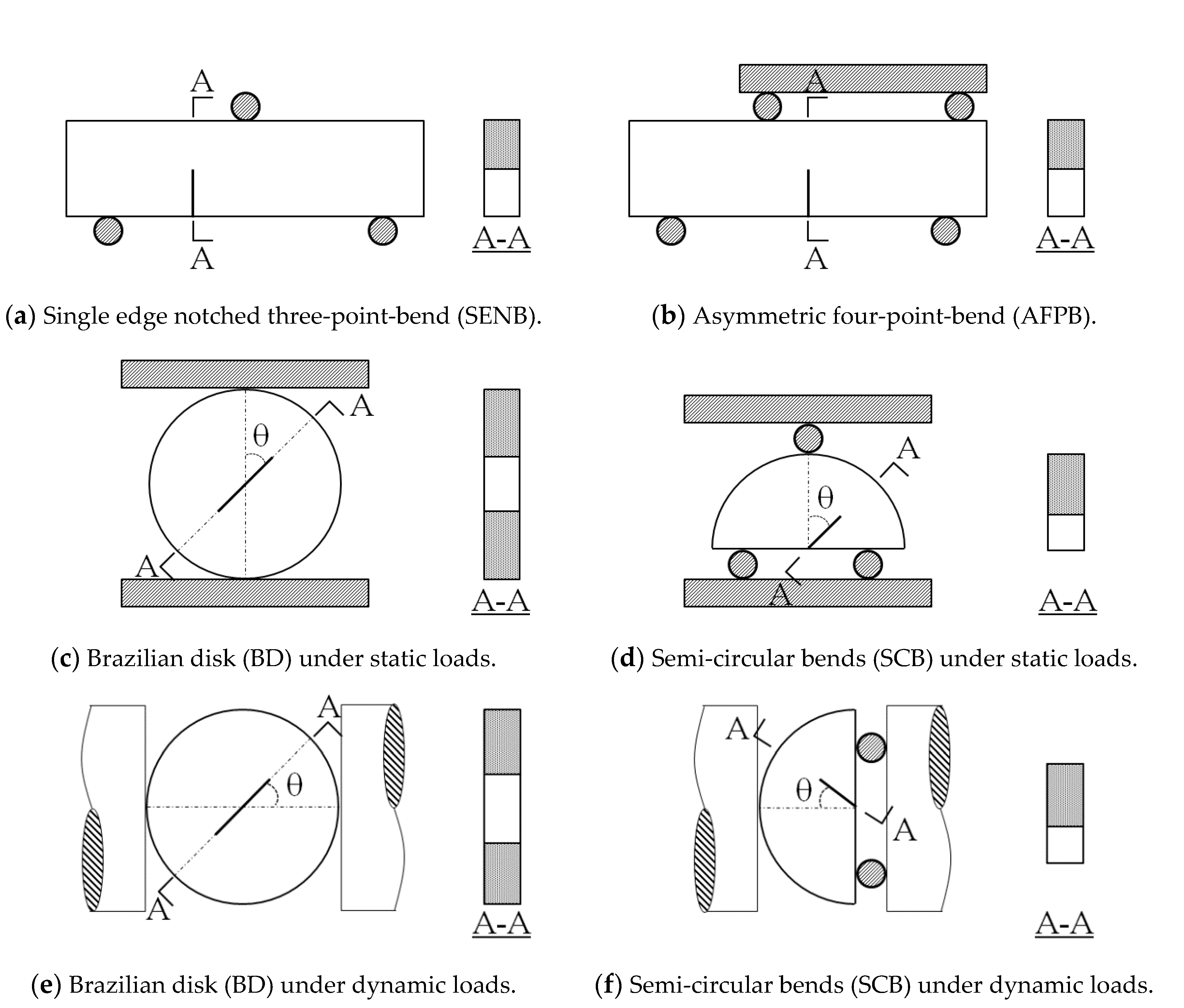

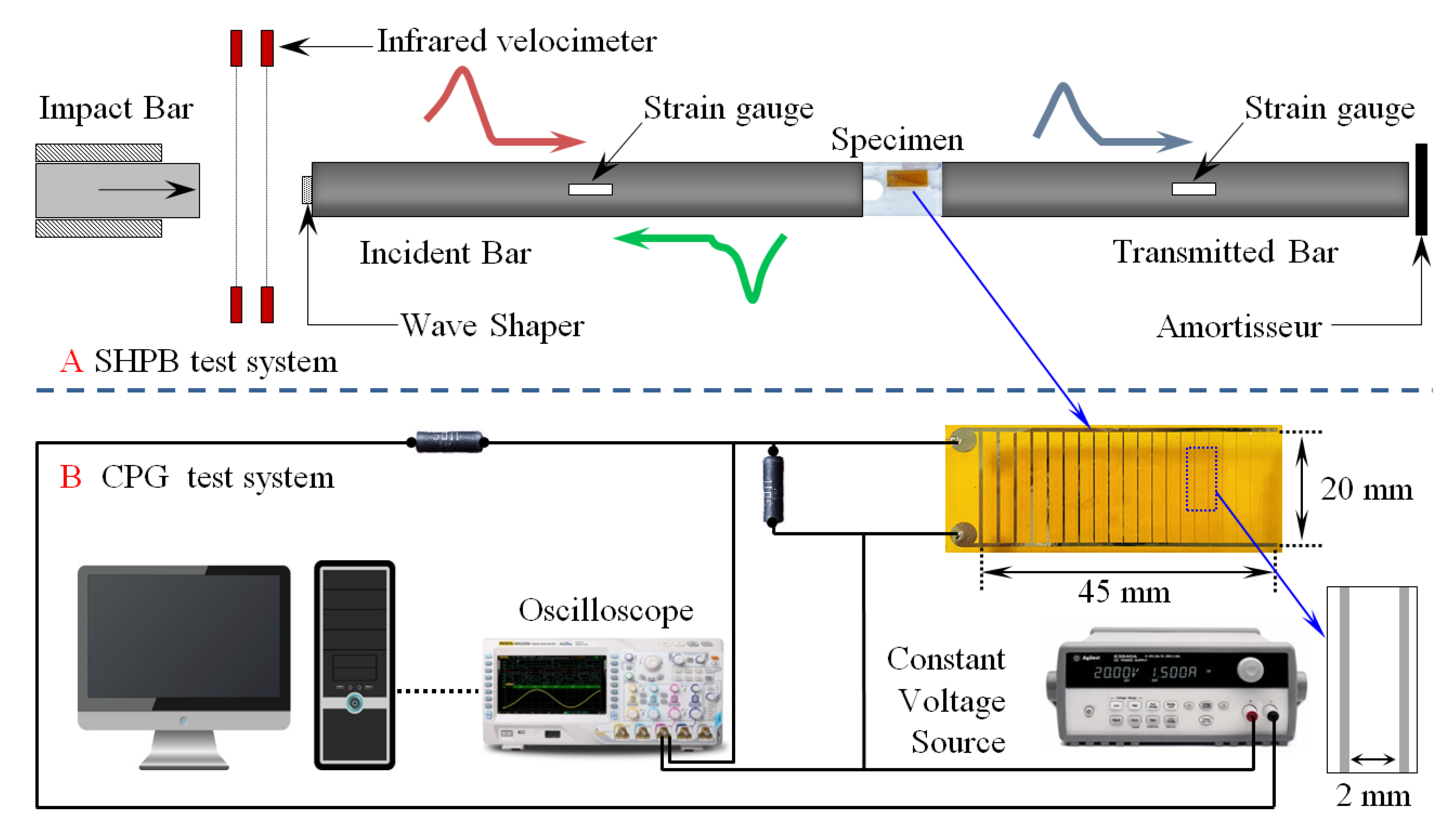
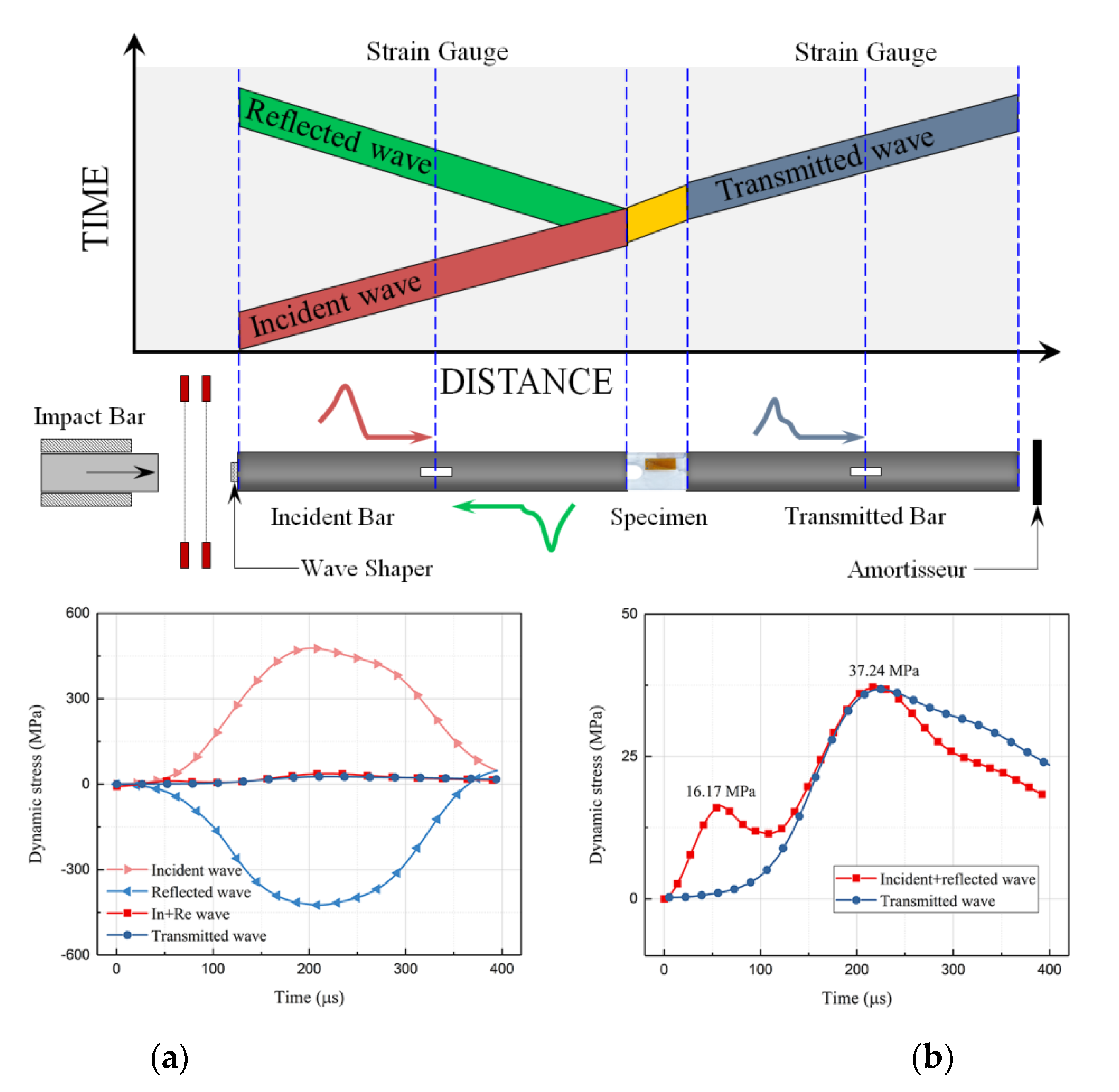
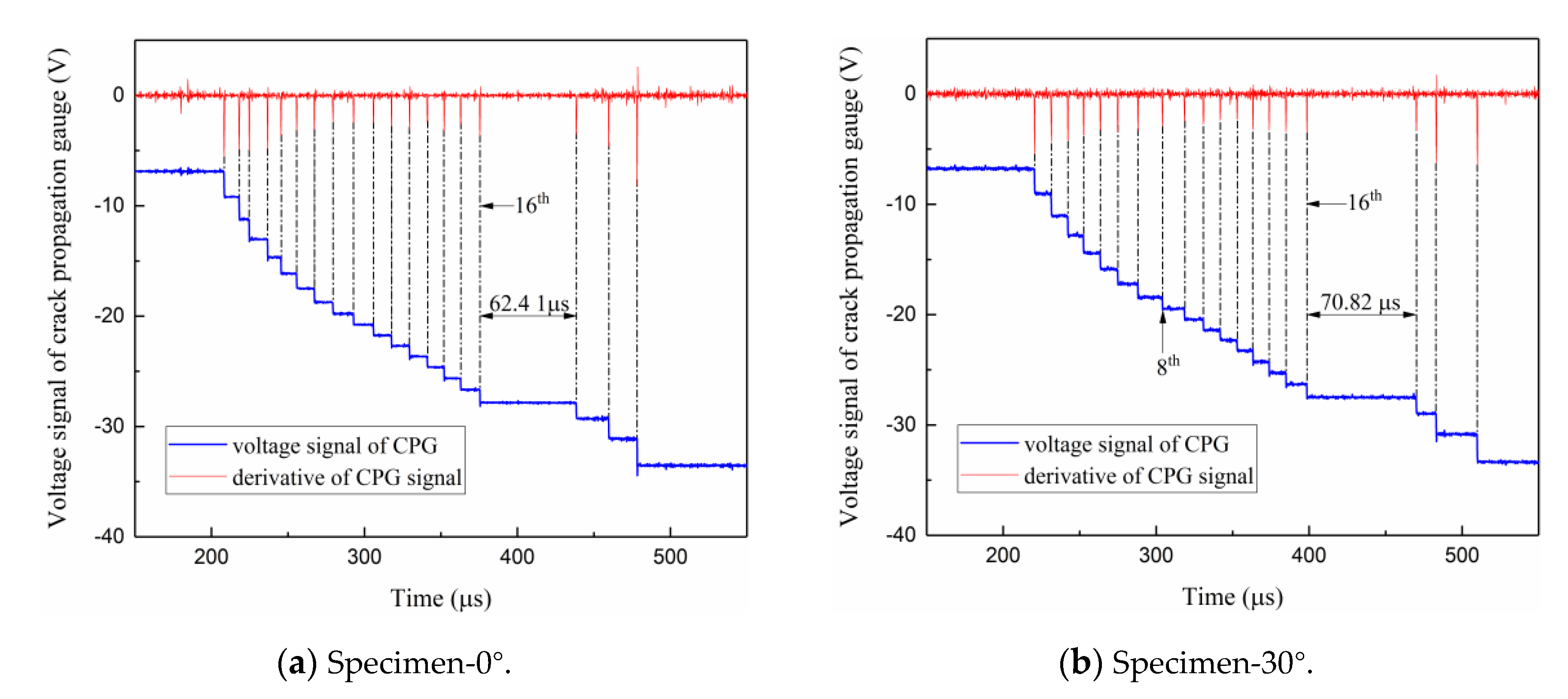
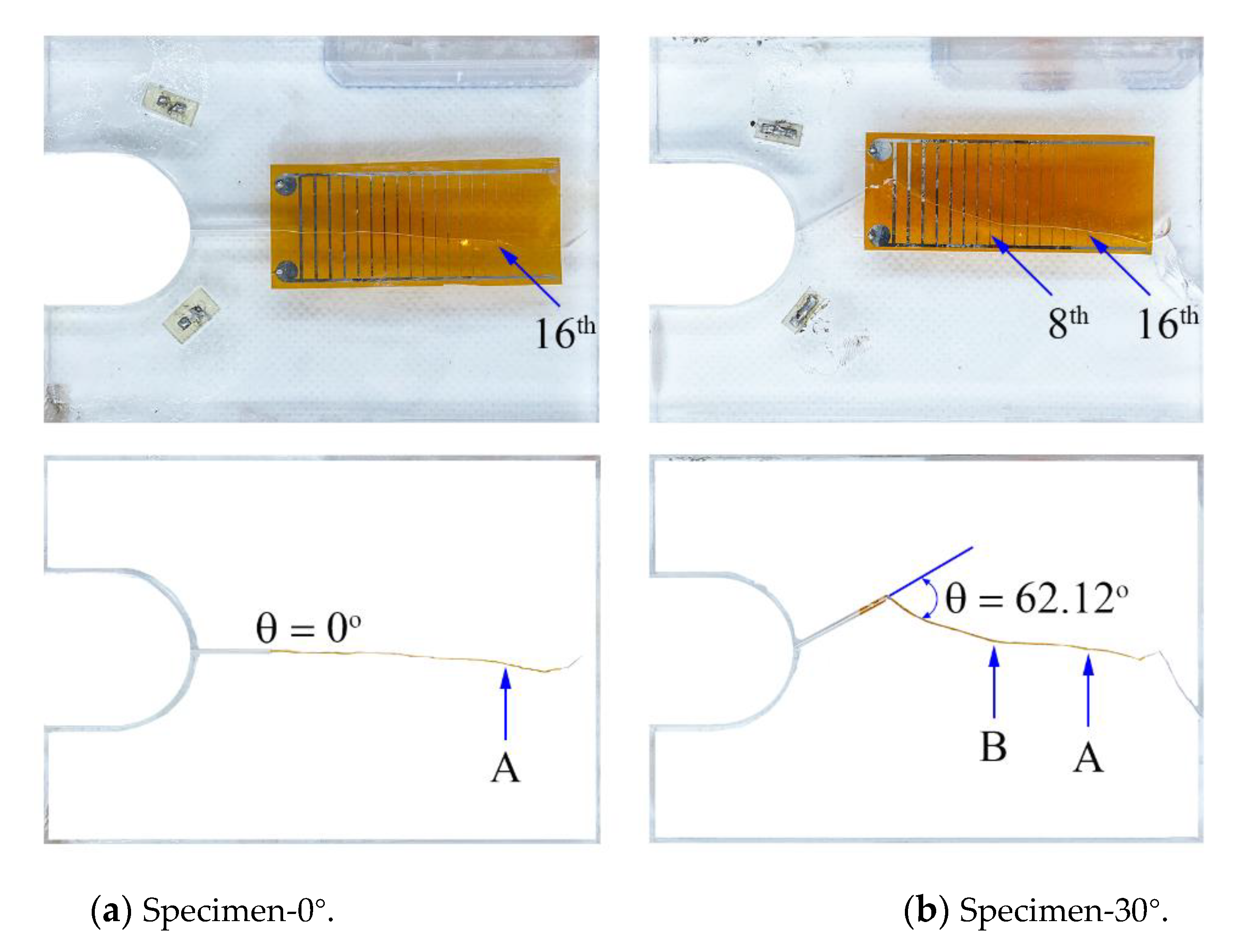
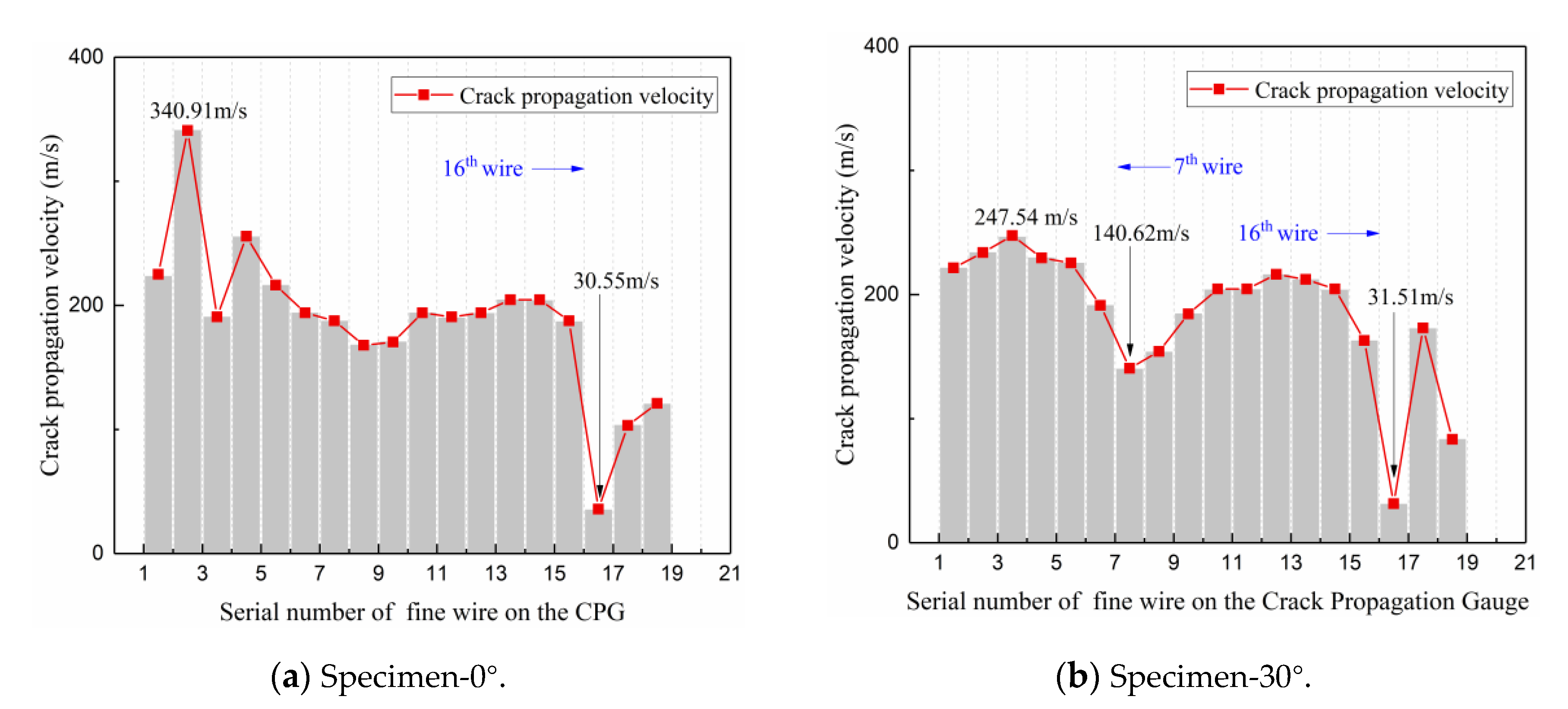

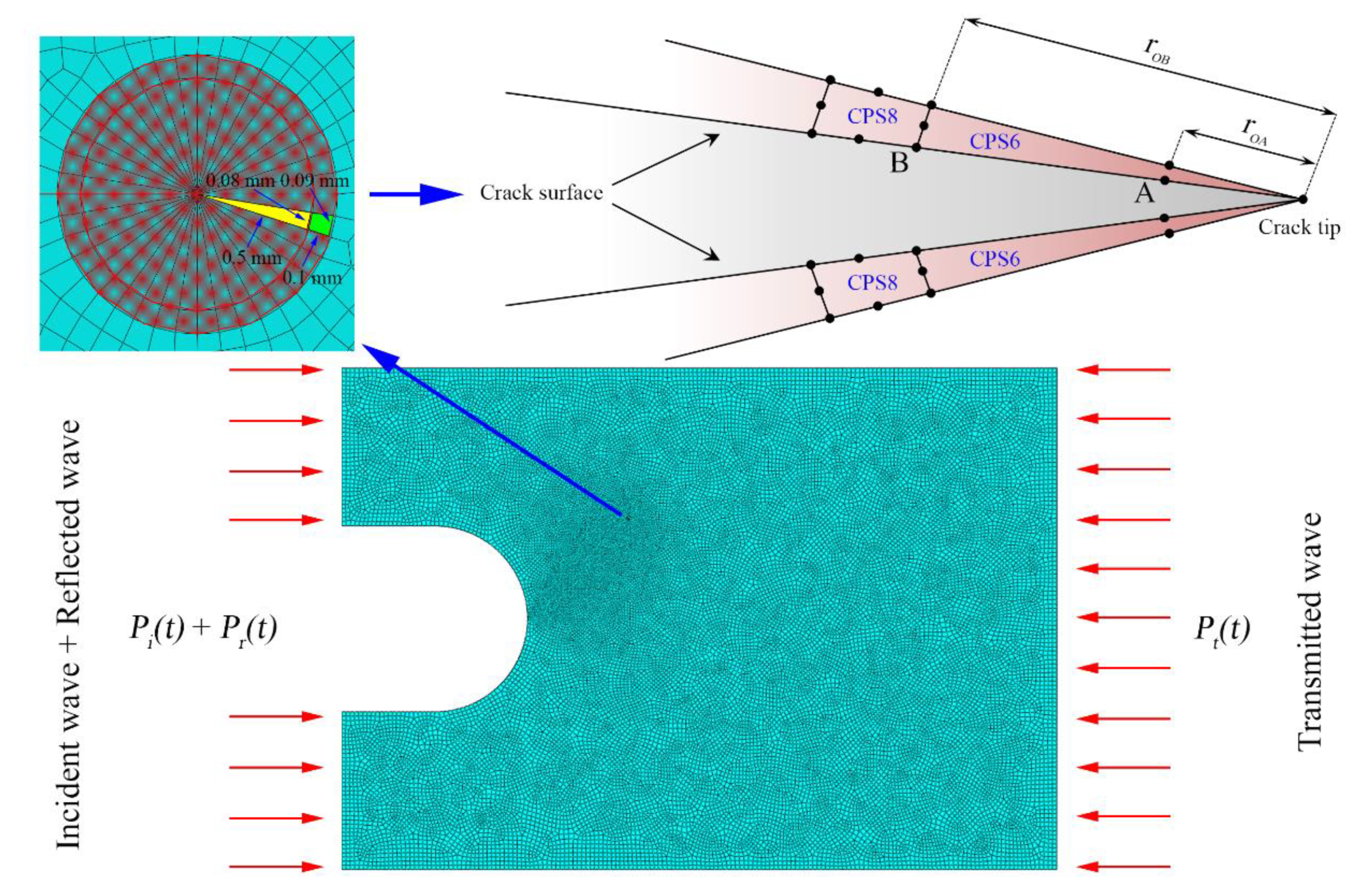
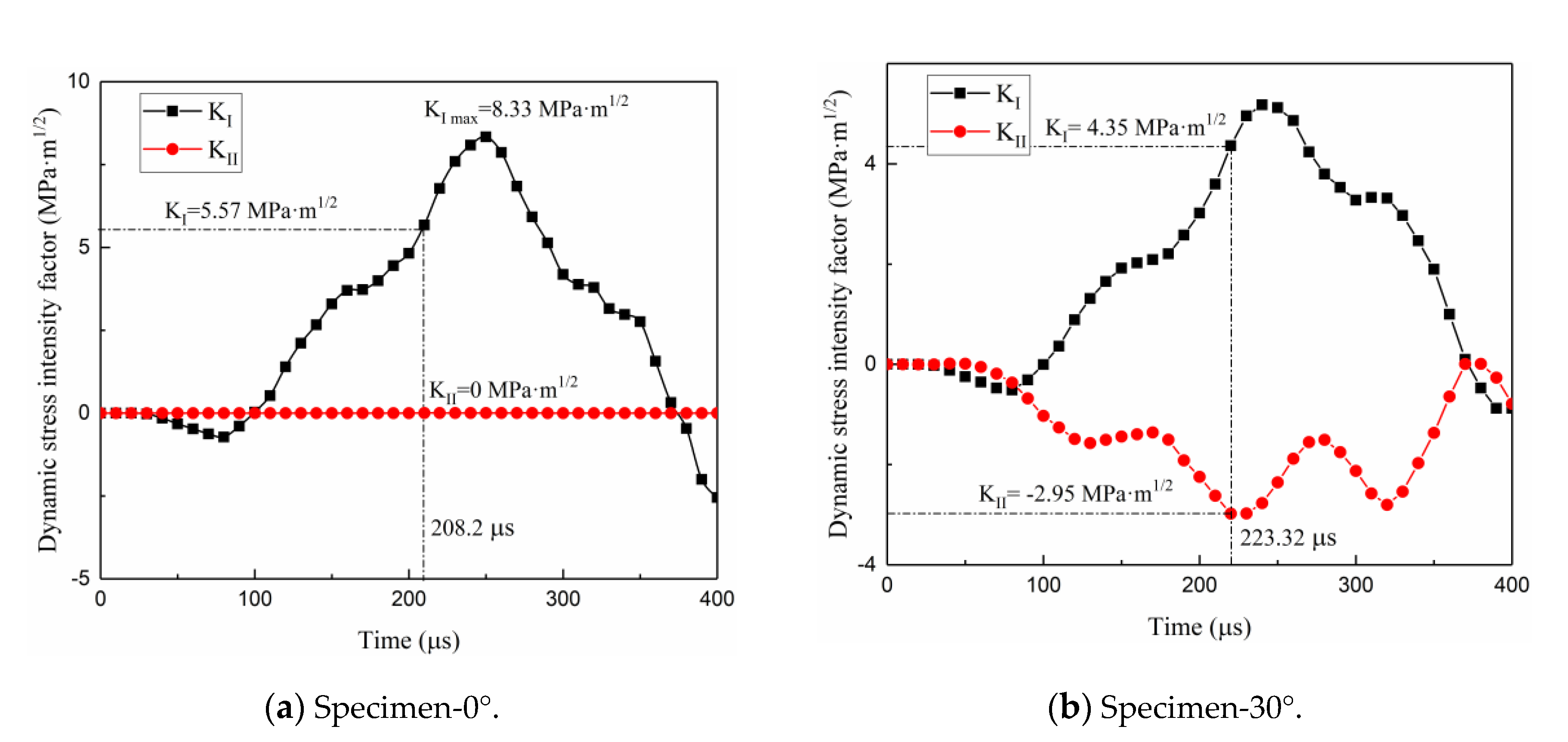
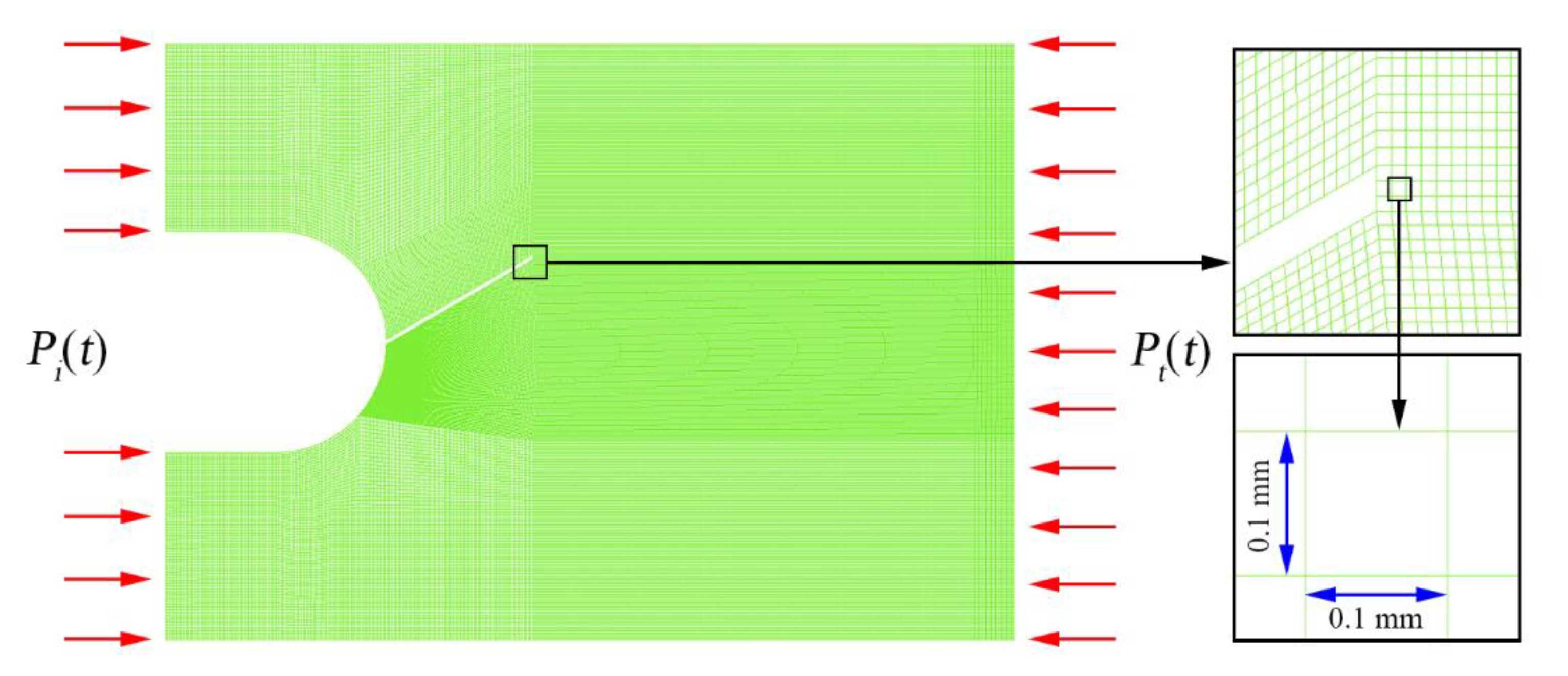
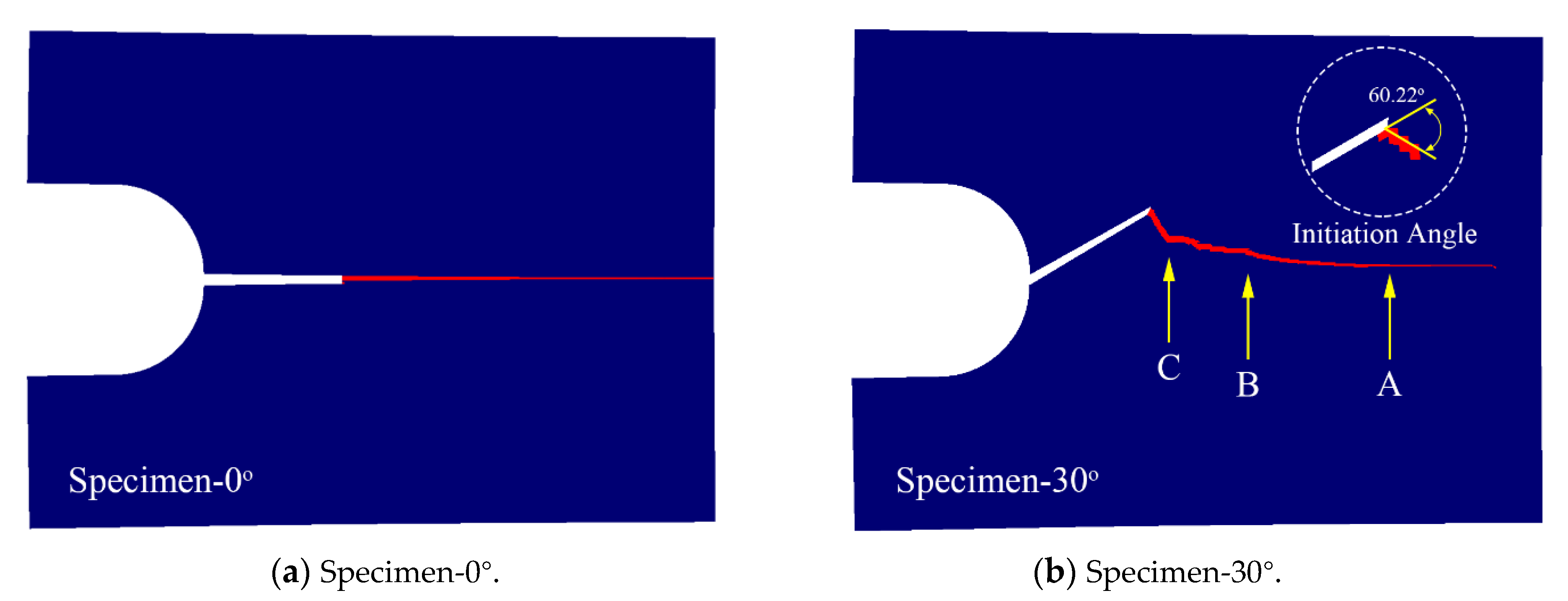
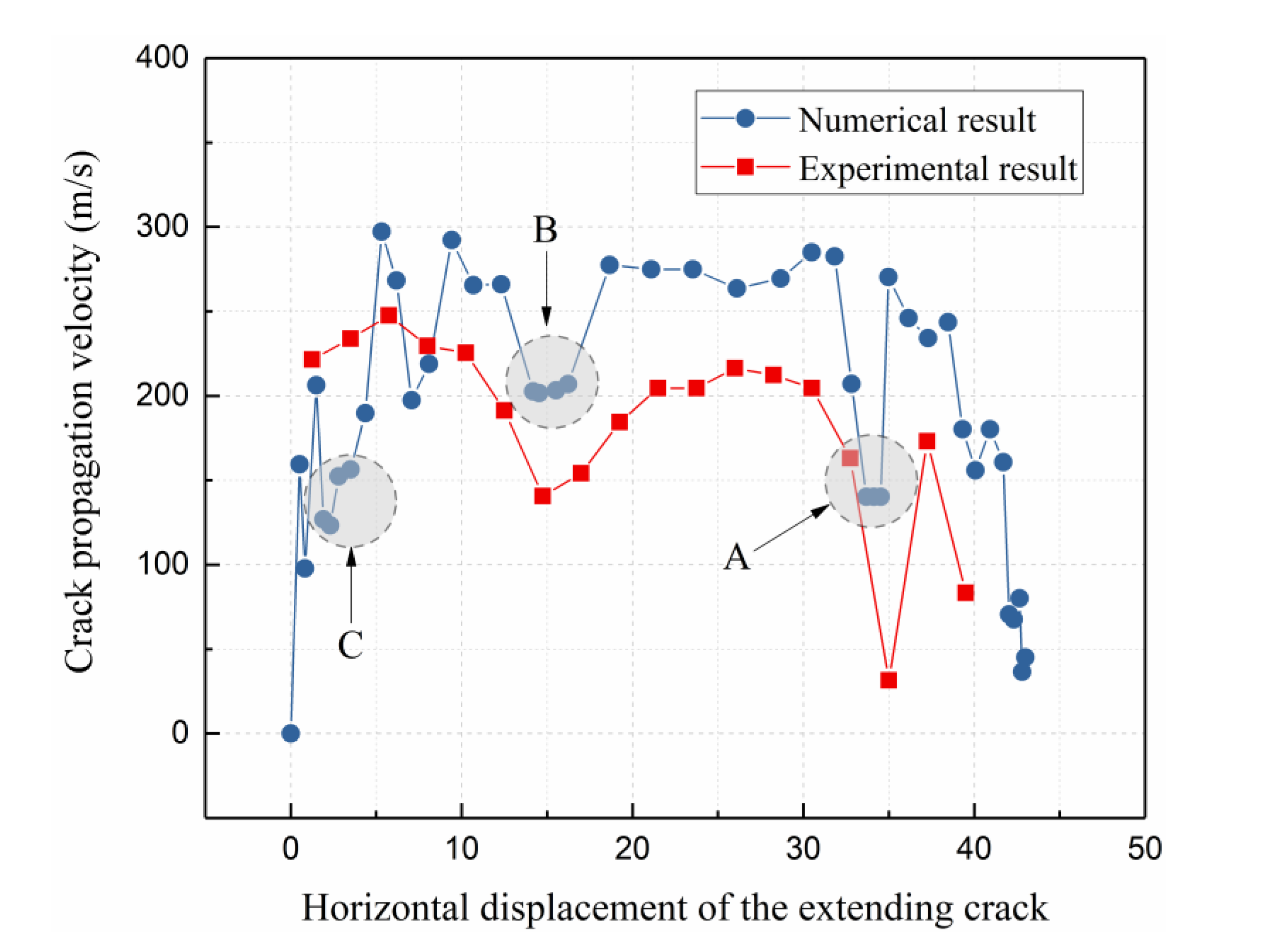

| Material | Cd (m/s) | Cs (m/s) | ρ (kg/m3) | Ed (GPa) | k (GPa) | νd |
|---|---|---|---|---|---|---|
| PMMA | 2382 | 1305 | 1187 | 5.61 | 4.35 | 0.28 |
| Name | Material | Length (mm) | Diameter (mm) | ρ (kg/m3) | Ed (GPa) | νd |
|---|---|---|---|---|---|---|
| Incident Bar | 40CrmoV | 3000 | 80 | 7600 | 210 | 0.25 |
| Transmitted Bar | 40CrmoV | 2000 | 80 | 7600 | 210 | 0.25 |
Publisher’s Note: MDPI stays neutral with regard to jurisdictional claims in published maps and institutional affiliations. |
© 2020 by the authors. Licensee MDPI, Basel, Switzerland. This article is an open access article distributed under the terms and conditions of the Creative Commons Attribution (CC BY) license (http://creativecommons.org/licenses/by/4.0/).
Share and Cite
Wang, F.; Zhu, Z.; Wang, M.; Qiu, H.; Zhou, L.; Liu, R.; Ying, P. Investigation of Mixed-Mode I/II Fracture under Impact Loading Using Split-Hopkinson Pressure Bar. Appl. Sci. 2020, 10, 7149. https://doi.org/10.3390/app10207149
Wang F, Zhu Z, Wang M, Qiu H, Zhou L, Liu R, Ying P. Investigation of Mixed-Mode I/II Fracture under Impact Loading Using Split-Hopkinson Pressure Bar. Applied Sciences. 2020; 10(20):7149. https://doi.org/10.3390/app10207149
Chicago/Turabian StyleWang, Fei, Zheming Zhu, Meng Wang, Hao Qiu, Lei Zhou, Ruifeng Liu, and Peng Ying. 2020. "Investigation of Mixed-Mode I/II Fracture under Impact Loading Using Split-Hopkinson Pressure Bar" Applied Sciences 10, no. 20: 7149. https://doi.org/10.3390/app10207149
APA StyleWang, F., Zhu, Z., Wang, M., Qiu, H., Zhou, L., Liu, R., & Ying, P. (2020). Investigation of Mixed-Mode I/II Fracture under Impact Loading Using Split-Hopkinson Pressure Bar. Applied Sciences, 10(20), 7149. https://doi.org/10.3390/app10207149





